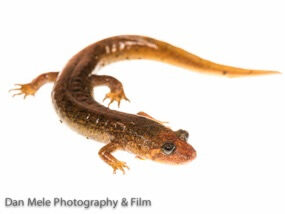Micah Jasny is a graduate student from the Nicholas School of the Environment at Duke University working this summer as an E.O. Wilson Biodiversity Foundation intern, as part of the ATBI/BioBlitz SWAT Team. His work is supported through a partnership with Discover Life in America. This summer he will try to discover new species to add to the park inventories in order to better understand park ecosystems and how to care for them. He also plans to help other scientists working in the park with their biodiversity surveys and scientific research. In the upcoming weeks, he will give weekly updates about his forays into the park and report back on his biodiversity research.
Searching for the Elusive Green Salamander
We recently received a report that an extremely rare salamander, the green salamander (Aneides aeneus) had been spotted along one of the trails not far from DLIA headquarters so the DLiA interns, Dan and Mark, and I decided to investigate. The green salamander has dark black skin with bright, moss-green patches from snout to tail. The green salamander is lungless, conducting respiration through its skin and mouths, and is believed to have inhabited the ancient chestnut forest that covered much of the Great Smoky Mountains. However, the chestnut blight wiped out most of the chestnut forest in the Smokies and thus, most of the green salamander habitat. While the green salamander has seemingly disappeared from the GSMNP, they can still be found in other regions of the eastern United States usually hiding in the crevices of rocks or under bark near water.
Dan, Mark, and I met at dusk and drove into the park. A couple of miles from the trail, we curved around a ridge and I had to hit the brakes as my high-beams fell upon a couple of black bears standing in the road. The bears had been ambling along the road, but quickly ducked back into the woods when faced with my frightening Honda Accord. While I can’t be certain, they seemed to be larger than cubs as both could easily have been 5 to 6 feet tall.


Photograph courtesy of Dan Mele Photography & Film
Following this encounter, we finally arrived at the trailhead as dusk began turning to night. We dawned our headlamps and continued on our journey by foot. We were talking about how we should hike quickly up the trail to make it to the waterfall at the top sooner when we encountered into a second couple of bears. From their size, we concluded that these two were probably cubs, which made us nervous because we knew their mother probably wasn’t far away. We cautiously backtracked down the trail to give the bears some time to move away. We talked loudly, making noise to let them know that we were still in close proximity. After a few minutes, we were able to resume our trek uphill, but we continued to talk loudly in case there were any more bears ahead of us.
As we walked up the trail, the path ahead of us illuminated by our headlamps, the only sounds were the ruffling of leaves in the winds, the babble of the creek next to the trail, and the crunch of rocks and branches under foot. We stopped at a few shallow creeks that crossed the trail and started searching for salamanders. We quickly began finding numerous black bellied salamanders (Batrachoseps nigriventris) which are black and mottled with a darker green than would be found on the green salamander. Some of these were actually quite large, with a few individuals as big as five to six inches.
We eventually reached the waterfall that marks the end of the path where we all spread out and began searching the area for green salamanders. We shuffled through rocks on the edge of the pool that lies beneath the waterfall, looked along damn rock walls, and looked in the crevices in and under loose bark. In addition to finding more black salamanders, we also found red-cheeked salamanders (Plethodon jordani) which have a dark bluish-green color as well as a Blue Ridge two-lined salamander (Eurycea wilderae) that has two black stripes running down its green and yellow back.
A quick note on trying to catch salamanders: they are very quick and can easily squirm from one’s grip. Dan and Mark had both had previous experience collecting salamanders with a visiting scientist before and therefore were much more adept at handling the little buggers. Whenever I was handling the salamanders, I was always worried that I was going to hurt them if I held on too tight. Nevertheless, I was able to collect a couple and did not harm any. Unfortunately, we did not find any green salamanders, but we were able to get some beautiful pictures of black salamanders and red-cheeked salamanders thanks to Dan. In the end, it was great to go out in the field at night and experience the park and its more nocturnal inhabitants.

